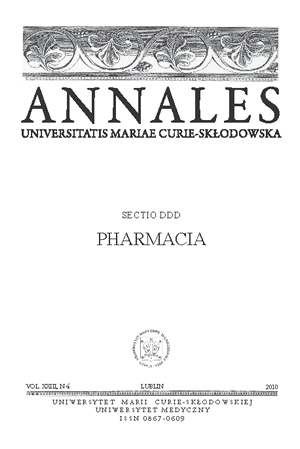The evaluation of rat peripheral blood morphology after coadministration of doxorubicin and tirapazamine
Keywords:
doxorubicin, tirapazamine, blood toxicityAbstract
Some cancer cells are typically characterized by hypoxia which is more resistant to radiotherapy and most common anticancer drugs. These specific phenomena encouraged researchers to the investigate new hypoxic-cell-selective cytotoxins. Tirapazamine (TPZ) is a representative of the drug-candidates group which demonstrates a considerable higher cytotoxic effect against hypoxic and then normoxic tumor cells studied under the same conditions. Taking into account that solid tumor does not only consist of hypoxic but also normoxic cells, a rational therapy should combine administration of classical anticancer therapy and TPZ. Results of some studies conducted under laboratory conditions indicated some benefits of such a schedule. Because doxorubicin (DOX), a widely used chemotherapeutic drug, has a similar mechanism of action as TPZ, we tested the hypothesis assuming interaction of both compounds in rats referring to blood toxicity. In this study we evaluated peripheral blood automatic smear in rats repeatedly treated with both DOX and TPZ. The major findings are that TPZ may statistically significantly change the relative amount of lymphocytes, MPV MCV and RDW in rats treated with DOX. Collectively, these findings suggest interactions between TPZ and DOX in relation to some red cells, white cells and platelets parameters, but the clinical risk of this phenomenon seems to be acceptable during chemotherapy. However, future studies are needed to assess the importance of anisocytosis as a result DOX-TPZ interaction.
References
1. Bourhis J.: Hypoxia response pathways and radiotherapy for head and neck cancer. J. Clin. Oncol., 10, 725,2006.
2. Brizel D.M. et al.: Tumor hypoxia adversely affects the prognosis of carcinoma of the head and neck. Int. J. Radiat. Oncol. Biol. Phys., 38, 285, 1997.
3. Dorie M.J., Brown J.M.: Modification of the antitumor activity of chemotherapeutic drugs by the hypoxic cytotoxic agent tirapazamine. Cancer Chemother. Pharmacol., 39, 361, 1997.
4. Elwell J.H. et al.: Adaptation of human tumor cells to tirapazamine under aerobic conditions: implications of increased antioxidant enzyme activity to mechanism of aerobic cytotoxicity. Biochem. Pharmacol., 54, 249, 1997.
5. Evans G.O.: Animal Hematotoxicology: A Practical Guide for Toxicologists and Biomedical Researchers. CRC Press, Taylor and Francis Group, p. 185, Boca Raton 2009.
6. Fyles A.W. et al.: Oxygenation predicts radiation response and survival in patients with cervix cancer. Radiother. Oncol., 48, 149, 1998.
7. Ganley B, et al.: Redox-activated, hypoxia-selective DNA cleavage by quinoxaline 1,4-di-N-oxide. Bioorg. Med. Chem., 9, 2395, 2001.
8. Gatenby R.A. et al.: Cellular adaptations to hypoxia and acidosis during somatic evolution of breast cancer. Br. J. Cancer., 97, 646, 2007.
9. Höckel M. et al.: Oxygenation of carcinomas of the uterine cervix: evaluation by computerized O2 tension measurements. Cancer Res., 51, 6098, 1991.
10. Holden S.A. et al.: Enhancement of alkylating agent activity by SR-4233 in the FSaIIC murine fibrosarcoma. J. Natl. Cancer Inst., 84, 187, 1992.
11. Horsman M.R.: Measurement of tumor oxygenation. Int. J. Radiat. Oncol. Biol. Phys., 42, 701, 1998.
12. Kaushansky K.: Lineage-specific hematopoietic growth factors. N. Engl. J. Med., 354, 2034, 2006.
13. Lippincott Williams and Wilkins. Chemotherapy Source Book. Editors: Perry M.C.,3rd Edition, Philadelphia 2001.
14. Minotti G. et al.: Anthracyclines: molecular advances and pharmacologic developments in antitumor activity and cardiotoxicity. Pharmacol. Rev., 56, 185, 2004.
15. Nordsmark M., Overgaard J.: A confirmatory prognostic study on oxygenation status and loco-regional control in advanced head and neck squamous cell carcinoma treated by radiation therapy. Radiother. Oncol., 57, 39, 2000.
16. Rauth A.M. et al.: Bioreductive therapies: an overview of drugs and their mechanisms of action. Int. J. Radiat. Oncol. Biol. Phys., 42, 755, 1998.
17. Reddy S.B., Williamson S.K.: Tirapazamine: a novel agent targeting hypoxic tumor cells. Expert Opin. Investig. Drugs., 18, 77, 2009.
18. Riddick D.S. et al.: Cancer chemotherapy and drug metabolism. Drug Metab. Dispos., 33, 1083, 2005.
19. Rischin D. et al.: Tirapazamine, cisplatin, and radiation versus cisplatin and radiation for advanced squamous cell carcinoma of the head and neck (TROG 02.02, HeadSTART): a phase III trial of the Trans-Tasman Radiation Oncology Group. J. Clin. Oncol., 28, 2989, 2010.
20. Spiegel J.F. et al.: Toxicology of daily administration to mice of the radiation potentiator SR 4233 (WIN 59075). Radiother. Oncol., 26, 79, 1993.
21. Stnczak A., Szumilak M.: Prodrugs in cacncer therapy. Part IV Hipoxia activated prodrugs. Farm. Przegl. Nauk., 7, 1519, 2010.
22. Vaupel P.W., Höckel M.: Oxigenation status of human tumors. A reappraisal using copmuteraized pO2 histography. In Tumor oxigenation (Eds. Vaupel PW, Kellerer DK and Gunderoph M), 219, Gustav Fisher, Stuttgart 1995.
23. Walton M.I. et al.: The role of cytochrome P450 and cytochrome P450 reductase in the reductive bioactivation of the novel benzotriazine di-N-oxide hypoxic cytotoxin 3-amino-1,2,4-benzotriazine-1,4-dioxide (SR 4233, WIN 59075) by mouse liver. Biochem. Pharmacol., 44, 251, 1992.
24. White I.N. et al.: Acute lesions in rats caused by 3-amino-1,2,4-benzotriazine-1,4-dioxide (SR 4233) or nitromin: a comparison with rates of reduction in microsomal systems from target organs. Arch. Toxicol., 66, 100, 1992.
25. Zeman E.M. et al.: SR-4233: a new bioreductive agent with high selective toxicity for hypoxic mammalian cells. Int. J. Radiat. Oncol. Biol. Phys., 12, 1239, 1986.
Downloads
Published
Issue
Section
License
Copyright (c) 2010 Authors

This work is licensed under a Creative Commons Attribution-NonCommercial-NoDerivatives 3.0 Unported License.


